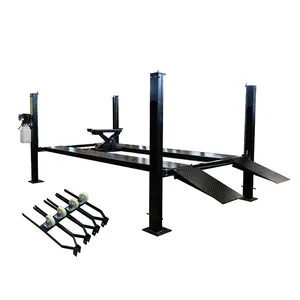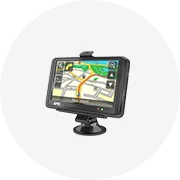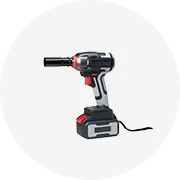Types of 2-Level Parking Lifts
A 2-level parking lift is a specialized parking equipment designed to maximize parking space by enabling two vehicles to be parked in the same footprint. These innovative solutions are increasingly popular in urban environments where space is at a premium.
Industry Insight: According to parking industry statistics, implementing 2-level parking systems can increase parking capacity by up to 100% without expanding the facility's footprint.
Stacker Parking Lift
This common residential solution stacks one vehicle directly above another using hydraulic systems that raise and lower the upper parking platform. Ideal for limited spaces, stacker lifts come in various configurations, including twin stackers capable of lifting two cars simultaneously.
Best for: Residential garages, small commercial lots, simple installation needs
Shuttle Parking Lift
Employing a dynamic shuttle system that moves along tracks, these lifts transport vehicles to designated parking spaces. The shuttle mechanism enables efficient vehicle organization and retrieval, making these systems ideal for high-traffic commercial environments.
Best for: Public parking facilities, valet services, medium-sized lots
Rotary Parking Lift
These innovative systems arrange vehicles in a circular configuration and utilize rotational movement to access parked vehicles. Their unique spatial efficiency makes them perfect for constrained urban environments where traditional parking layouts aren't feasible.
Best for: Urban settings, irregular footprints, maximizing corner spaces
Turntable Parking Lift
Featuring rotating platforms, turntable lifts simplify vehicle maneuvering by rotating cars to face the exit. This eliminates difficult reverse maneuvers in tight spaces and enhances overall parking efficiency. The turntable mechanism reduces space needed for turning radius.
Best for: Narrow entrances/exits, limited maneuvering space, luxury applications
Slide Parking Lift
Using sliding platform technology, these systems enable lateral movement of vehicles to create additional parking capacity. Vehicles park on platforms that slide horizontally, creating dynamic space utilization that adapts to changing parking needs.
Best for: Rectangular spaces, multiple access points, flexible layouts
Scissor Parking Lift
Named for their distinctive scissor-like lifting mechanism, these robust systems provide vertical stacking capabilities with excellent stability. The scissor design distributes weight evenly and offers reliable performance even for heavier vehicles.
Best for: Heavier vehicles, long-term parking solutions, industrial applications
| Lift Type | Primary Movement | Space Efficiency | Installation Complexity | Best Application |
|---|---|---|---|---|
| Stacker | Vertical | High | Low | Residential |
| Shuttle | Horizontal + Vertical | Very High | High | Commercial |
| Rotary | Circular | Very High | High | Urban Centers |
| Turntable | Rotational | Medium | Medium | Luxury Properties |
| Slide | Lateral | High | Medium | Mixed-Use Buildings |
| Scissor | Vertical | High | Low | Industrial/Commercial |
Specifications and Maintenance of 2-Level Parking Lifts
Key Technical Specifications
Understanding the technical specifications of 2-level parking lifts is crucial for selecting the appropriate system for your specific requirements. Here are the essential specifications to consider:
Load Capacity
The maximum weight the lift can safely support, typically ranging from 6,000 to 12,000 lbs. Choose a lift with at least 20% greater capacity than your heaviest vehicle to ensure safe operation and longevity of the equipment.
Lift Height
The maximum vertical distance the lift can raise vehicles, usually between 60-84 inches. This specification determines clearance requirements and affects the types of vehicles that can be accommodated on both levels.
Platform Size
The dimensions of the parking platform, typically 72-84 inches wide by 180-220 inches long. Platform size must accommodate your largest vehicle with sufficient clearance for doors to open and occupants to enter/exit safely.
Overall Dimensions
The total footprint of the installed lift system, including supporting structures and access areas. These dimensions are critical for installation planning and space allocation within your facility.
Power Supply
Most systems require 220V single-phase power, though requirements vary by manufacturer and lift capacity. Some high-capacity commercial systems may require 3-phase power for optimal performance.
Construction Material
Typically constructed from high-strength steel with powder-coated finishes for corrosion resistance. Premium models may feature galvanized or stainless steel components for enhanced durability in humid environments.
Safety Note: Always verify the actual dimensions and specifications of your vehicles before purchasing a parking lift. Many manufacturers offer customization options to accommodate specific vehicle profiles or installation constraints.
Maintenance Requirements
Proper maintenance is essential to ensure the safety, reliability, and longevity of your 2-level parking lift system. Following these maintenance protocols will help prevent costly repairs and minimize downtime:
| Maintenance Task | Frequency | Description | Importance |
|---|---|---|---|
| Visual Inspection | Daily | Check for visible damage, wear, loose components, and proper operation | Critical |
| Lubrication | Weekly | Apply approved lubricants to moving components including chains, pulleys, and lift arms | High |
| Hydraulic Fluid Check | Monthly | Verify fluid levels and check for leaks or contamination | Critical |
| Hardware Tightening | Monthly | Inspect and tighten all bolts, nuts, and fasteners | High |
| Platform Cleaning | Weekly | Remove debris, dirt, and fluids from platforms and surrounding areas | Medium |
| Professional Inspection | Annually | Comprehensive evaluation by certified technicians with specialized equipment | Critical |
| Hydraulic Fluid Replacement | Annually | Complete replacement of hydraulic fluid according to manufacturer specifications | High |
Maintenance Tip: Keep a detailed maintenance log for your parking lift system. This documentation not only helps track the system's condition over time but may also be required for warranty purposes and could be valuable if you sell the property in the future.
How to Choose the Right 2-Level Parking Lift
Selecting the optimal parking lift for your specific needs requires careful consideration of multiple factors. This comprehensive selection guide will help you navigate the decision-making process:
Selection Criteria Priority Chart
When evaluating 2-level parking lifts, consider these factors in order of importance:
- Safety Features & Compliance - Non-negotiable priority
- Load Capacity & Vehicle Compatibility - Must accommodate all intended vehicles
- Space Requirements & Facility Constraints - Physical installation limitations
- Operational Efficiency & Ease of Use - Daily usability factors
- Initial Cost & Long-term Value - Financial considerations
- Maintenance Requirements - Ongoing support needs
Space Availability Assessment
Before selecting a parking lift, carefully measure your installation area, considering:
- Floor space dimensions (width × length)
- Ceiling height and overhead clearance
- Access points and approach angles
- Structural support locations
- Expansion space for future needs
Expert Tip: Add at least 24 inches to your largest vehicle's dimensions when determining space requirements for comfortable access and operation.
Vehicle Profile Analysis
Create a comprehensive inventory of vehicles to be accommodated:
- Maximum and average vehicle weights
- Tallest vehicle height (with roof accessories)
- Longest vehicle length (including front/rear overhangs)
- Widest vehicle width (including mirrors)
- Special requirements (low clearance, wide turning radius)
Safety Rule: Choose a lift with capacity rating at least 25% higher than your heaviest vehicle.
Operational Considerations
Evaluate how the lift will be used on a daily basis:
- Frequency of vehicle exchanges
- User expertise level (trained operators vs. general public)
- Access control requirements
- Operating environment (temperature, humidity, exposure)
- Noise restrictions and acoustic considerations
Usability Factor: Systems requiring frequent access should prioritize speed and simplicity of operation.
Safety & Compliance Features
Ensure your selected lift includes these critical safety elements:
- Automated locking mechanisms at multiple positions
- Emergency stop controls accessible from multiple locations
- Overload protection systems
- Power failure safety protocols
- Compliance with ANSI/ALI ALCTV standards
- Warning indicators (visual and audible)
Regulatory Note: Verify compliance with local building codes and insurance requirements.
Decision-Making Strategy: Create a weighted scoring system for potential lift options by assigning importance values to each selection criterion. This systematic approach helps objectify the selection process and ensures that critical factors receive appropriate consideration.
DIY Installation & Replacement Guide for 2-Level Parking Lifts
While professional installation is recommended for most 2-level parking lift systems, experienced DIY enthusiasts with proper tools and mechanical knowledge can undertake this project with careful planning and attention to safety protocols.
Safety Warning: Improper installation of parking lifts can result in serious injury or death. Always consult professional installers for complex systems or if you lack experience with heavy mechanical equipment. This guide is provided for informational purposes only.
Pre-Installation Preparation
Read the Manual Thoroughly
Every parking lift comes with specific installation instructions from the manufacturer. Review this documentation completely before beginning installation, noting any special requirements or warnings. Manufacturer instructions always supersede general guidelines.
Prepare the Installation Site
Ensure the installation area meets all requirements:
- Level concrete floor of sufficient thickness (typically 4-6 inches reinforced concrete)
- Adequate ceiling height for lift clearance plus safety margin
- Proper ventilation for hydraulic system operation
- Sufficient lighting for safe operation and maintenance
- Cleared area around the installation site for assembly and access
Verify Power Supply
Confirm electrical requirements and ensure your facility can provide:
- Correct voltage and phase (typically 220V single-phase)
- Appropriate circuit breaker capacity
- Properly grounded connections
- Compliance with local electrical codes
- Professional electrical connections if required by local regulations
Installation Process
Assemble the Base Components
Begin with the foundation components, ensuring proper alignment and level installation. Follow these steps:
- Unpack and inventory all parts before beginning assembly
- Set base plates according to provided templates or measurements
- Use a laser level to ensure perfect alignment
- Anchor base components securely to the concrete floor
- Torque all fasteners to manufacturer specifications
Construct the Lift Structure
Work methodically from the base upward, following the manufacturer's assembly sequence:
- Erect vertical posts with temporary bracing as needed
- Install cross-members and structural supports
- Mount hydraulic cylinders according to specifications
- Install platforms and movement mechanisms
- Verify alignment at each stage before proceeding
Connect Hydraulic Systems
The hydraulic system is critical for safe operation:
- Install the power unit in the designated location
- Route hydraulic lines according to the provided diagram
- Use proper fittings and connectors to prevent leaks
- Fill the system with recommended hydraulic fluid
- Bleed the system to remove air before operation
Install Safety Devices
Safety systems must be properly installed and tested:
- Mount mechanical locks and safety latches
- Install limit switches and sensors
- Connect emergency stop circuits
- Verify proper function of all safety features
- Test under various scenarios including power loss
Testing and Commissioning
Perform Leveling Verification
Ensure the lift operates on a perfectly level plane:
- Check level at multiple positions throughout the lifting range
- Adjust leveling mechanisms as needed
- Verify equal weight distribution across all support points
- Test with and without load to confirm consistent operation
Conduct Operational Testing
Thoroughly test all functions before placing into service:
- Run the lift through multiple complete cycles without load
- Test with various load weights up to rated capacity
- Verify smooth operation throughout the entire range of motion
- Confirm proper function of all controls and indicators
- Document test results for future reference
Train Personnel
Ensure all users understand proper operation:
- Provide comprehensive training on normal operation procedures
- Review emergency protocols and safety features
- Demonstrate proper vehicle positioning and securing
- Explain maintenance requirements and schedules
- Create accessible reference materials for operators
Installation Tip: Take photographs at each stage of the installation process. These images can be invaluable for troubleshooting, maintenance reference, and if you need to consult with the manufacturer for support.
Frequently Asked Questions
A standard 2-post lift requires a minimum ceiling height of 8 feet (96 inches) for basic functionality. However, this is the absolute minimum and doesn't account for taller vehicles. For optimal versatility and safety, we recommend:
- Standard sedans and compact vehicles: 10-foot (120-inch) ceiling height
- SUVs and light trucks: 11-12 foot (132-144 inch) ceiling height
- Full-size trucks and vans: 13-14 foot (156-168 inch) ceiling height
Always add the height of your tallest vehicle plus a minimum 24-inch safety clearance to determine your specific ceiling height requirements.
Determining the appropriate lift capacity requires a comprehensive assessment of your vehicle fleet:
- Identify your heaviest vehicle: Check the manufacturer's specifications for Gross Vehicle Weight Rating (GVWR)
- Account for additional weight: Add weight for any modifications, cargo, or equipment typically carried
- Apply a safety margin: Industry standard recommends adding 25% to the total weight
- Consider future needs: If you might upgrade to heavier vehicles, factor this into your calculations
For example: If your heaviest vehicle weighs 4,800 lbs, calculate: 4,800 × 1.25 = 6,000 lbs minimum capacity. When in doubt, always choose a higher capacity rating for enhanced safety and equipment longevity.
Yes, 2-post lifts can safely lift trucks provided that:
- The lift's rated capacity exceeds the truck's weight by at least 25%
- The lift arms can extend to properly reach the truck's recommended lifting points
- The truck's weight is evenly distributed between the two posts
- The lift features truck adapters if required by the manufacturer
- The concrete floor meets thickness and strength requirements (typically 4-6 inches of reinforced concrete)
Always consult the lift manufacturer's specifications regarding truck compatibility. Some truck models with unusual weight distributions may require specialized lifting equipment or 4-post lifts for optimal safety.
With proper maintenance and usage, a quality 2-level parking lift can provide reliable service for:
- Light residential use: 15-20+ years
- Regular commercial use: 10-15 years
- Heavy-duty commercial use: 7-10 years
Factors that influence longevity include construction quality, operating environment (especially exposure to moisture or corrosive elements), adherence to maintenance schedules, and whether the lift is consistently used within its rated capacity.
When experiencing problems with your hydraulic parking lift, check these common issues:
- Lift won't raise: Check hydraulic fluid level, power supply, pressure relief valve setting
- Slow operation: Inspect for air in hydraulic lines, fluid viscosity issues, or pump wear
- Uneven lifting: Verify level installation, check for cylinder leaks, inspect synchronization cables/chains
- Unusual noises: Look for loose components, inadequate lubrication, or worn bearings
- Fluid leaks: Tighten fittings, replace damaged seals, inspect hoses for wear or damage
For persistent issues or problems involving safety systems, always consult a certified lift technician rather than attempting complex repairs yourself.



























































